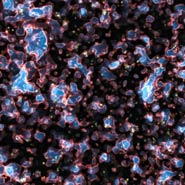The research, published in the journal Nature, was carried out by a team of European astronomers including Professor of Physics Malcolm Bremer from the University of Bristol, alongside colleagues from the Universities of Durham and Edinburgh. Using the European Southern Observatory’s (ESO’s) Very Large Telescope (VLT), the team measured the distance to the remote galaxy by analysing its faint glow of light.
Confirming the distance to such a remote object is hugely challenging, even using the largest ground-based telescopes such as the VLT. A major difficulty is that by the time the initially brilliant light of a young galaxy reaches Earth it appears extremely faint, and this remaining dim light falls mostly in the infrared part of the spectrum because its wavelength has been stretched by the expansion of the Universe – an effect known as redshift.
The team used a spectrograph on the VLT in order to split this infrared light into its component parts (analogous to splitting optical light into a rainbow by passing it through a prism) and then searched for the tell-tale signature of emission from hydrogen gas within the galaxy.
Following two months of careful observations and analysis, the team were able to measure the galaxy’s redshift spectroscopically by measuring the wavelength of the ‘Lyman-alpha’ emission from hydrogen atoms in the galaxy. This was achieved despite the potentially obstructive presence of the intervening hydrogen fog that absorbed the fierce ultraviolet light from young galaxies less than a billion years after the Big Bang, which makes the Lyman alpha emission from such galaxies particularly hard to detect.
The team detected light emission at a wavelength of 1.16 micrometres, which yielded a record-breaking redshift of 8.55 - the previous record holders were a galaxy at redshift 6.96 and a gamma-ray burst at a redshift of 8.2 (discovered last year by another team, again including Prof Bremer). A redshift of 8.6 corresponds to a galaxy seen just 600 million years after the Big Bang.
The newly discovered galaxy is particularly significant given that it dates back to the ‘epoch of reionization’, a time in the early Universe when radiation from primeval galaxies ionized the surrounding hydrogen gas, changing its physical state. As more galaxies from this epoch are discovered, it should become possible to determine the nature of the sources responsible for this crucial process in the Universe’s evolution.
Prof Bremer, co-author of the paper, said: “These observations are at the limit of what can be achieved with the best current technology on the best telescopes available today. In the near term, improvements to that technology and the launch of the James Webb Space Telescope (Hubble’s successor) will improve our ability to carry out studies like this. In the longer term, larger telescopes such as ESO's planned 42m E-ELT will be able to study in detail galaxies at these great distances using technology pioneered in the UK.”
